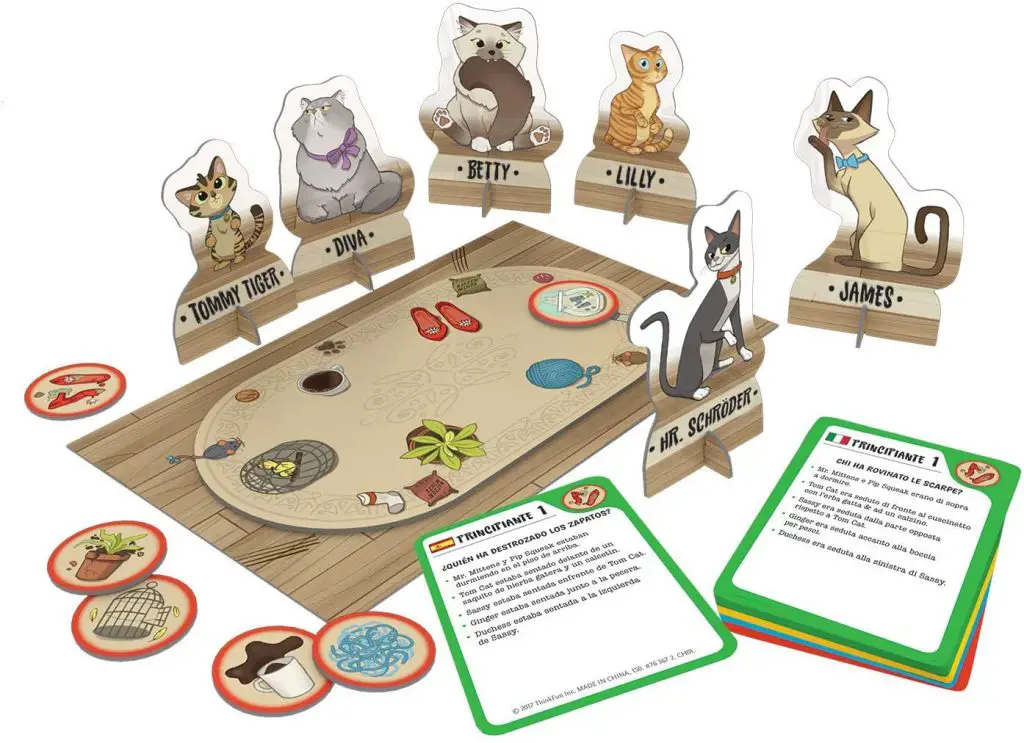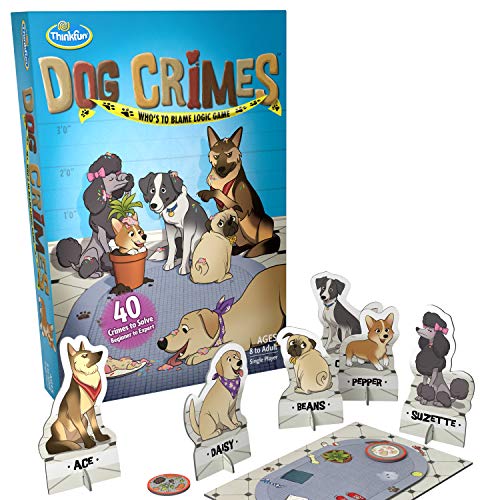Before we review how to play Cat Crimes, let’s talk about what it is and its main objective. When it comes to single-player games that are entertaining and stimulating mentally, Cat Crimes is up there with the best of them.
Cat Crimes is a logical deduction game that turns you into Sherlock Holmes for a couple of minutes as you try to get to the bottom of six crimes committed by adorable felines. There are a number of clues to help you complete over 40 challenges and find out which of the six cats is guilty. Neatly done illustrations and simple rules make Cat Crimes a joy for anyone above the age of eight to enjoy.
Read on to learn more on how to play Cat Crimes as well as some tips and tricks.
Object of Cat Crimes
Your aim when you play Cat Crimes is to use the clues provided to determine which of the six cats you were given to babysit is responsible for a variety of mishaps.
What’s in the Box (Contents)
On tearing open the package, or gift box, containing Cat Crimes, you will find the follow:

- One game board
- Six crime tokens
- Six cat tokens
- 40 challenge cards
- Game manual/ rule book
Setting up the Game
To get started, spread out the Cat Crimes board on a flat surface. The board is divided into six spaces and each of these should contain a cat token, a crime token, and two kinds of supporting evidence.
Pick a challenge card from the deck. Indicated on the top right corner of the card will be a symbol of the crime committed by one of the six cats. Find the crime token with a similar symbol and place it on the board where there is a corresponding symbol. For instance, if the crime is a spilt cup of coffee, identify this illustration on the board and place the coffee crime token there.
How to Play Cat Crimes
Number of Players and Playtime
Cat Crimes is single player board game, but nothing stops parents from helping their kids solve the crime. Playtime will largely depend on the players ability for deductive reasoning.
It will also depend on the difficulty level of the challenge cards. Cat Crimes challenge cards range from beginner to expert levels. It can take anywhere from a few minutes to a few hours depending on these factors. Once you’ve learned how to play Cat Crimes and have gone through a number of challenges, your playtime will steadily reduce.
Gameplay
After picking a challenge card, read it and pick the crime token with a matching illustration, placing it on the corresponding spot on the board as described above.

Go through the clues on the challenge card one by one. This will help you determine the placement of each of the cats on the board. Using your deductive reasoning skills, you will be able to match the traits of each of the cats to the clues mentioned in the challenge card.
It is up to you as the Cat Crime sleuth to sift out the two cat traits hidden among the clues in the challenge card. This will help you determine the position of each cat relative to the object of the crime or supporting evidence on the board. You also need to determine the position of each cat relative to other cats.
The Cats
Here are the six cats whose guilt, or innocence, you will be looking to prove with each challenge:
- Ginger
- Mt. Mittens
- Sassy
- Tom Cat
- Duchess
- Pip Squeak
Each of these feline suspects comes with a bio detailing their physical attributes as well as their personality quirks.
The Crimes
The challenges revolve around six basic crimes:
- A messed up ball of yarn
- A mutilated pair of shoes
- A spilt cup of coffee
- A missing bird
- A broken flowerpot
- A fishbowl with a missing fish
How to Win
You win by being able to identify and name the cat that is on front of the crime token. This can only happen after you’ve placed all the other cats on their rightful position on the board. To confirm if your suspicion is correct, flip over the challenge card. The flipside of each card shows the correct placement of the cats and will have the image of the guilty cat on the top right corner.
Tips and Tricks
- When a clue states that a cat was upstairs sleeping, they should be counted out of the crime scene.
- You don’t have to follow the clues in the order they are in the challenge card.
- Where hints from one clue seem to conflict with another, try to determine the final placement of cat(s) in question.
- In the same vein, it’s helpful to look for multiple clues that mention a single cat and try to use them together to determine its true position.
Other Cat Crimes Versions to Consider
Dog Crimes Logic Game
Here is a version of Cat Crimes for those who love dogs more than cats. It is made by the same game maker, ThinkFun, and pretty much follows the same format. The only difference, other than the type of guilty pet, is the theme color of the game and its illustrations. The crimes in question also differ slightly.
The rest of the elements are essentially copy-pasted from Cat Crimes; there are 40 challenge cards with the solutions at the back and six culprits with distinct characteristics.
Frequently Asked Questions
How Many Players can Play Cat Crimes?
As mentioned, Cat Crimes is a single player game. But again, nothing stops the player from eliciting assistance from anyone around them. Two heads are always better than one, and the more the merrier.
Is Cat Crimes Good for Travel?
Yes, Cat Crimes is not at all bulky and can be easily carried. It weighs just one pound and comes in a box just nine inches long. It won’t add much to your carry-on luggage in a flight.
Are there Expansions for Cat Crimes?
There are no expansions for Cat Crimes at this time.







